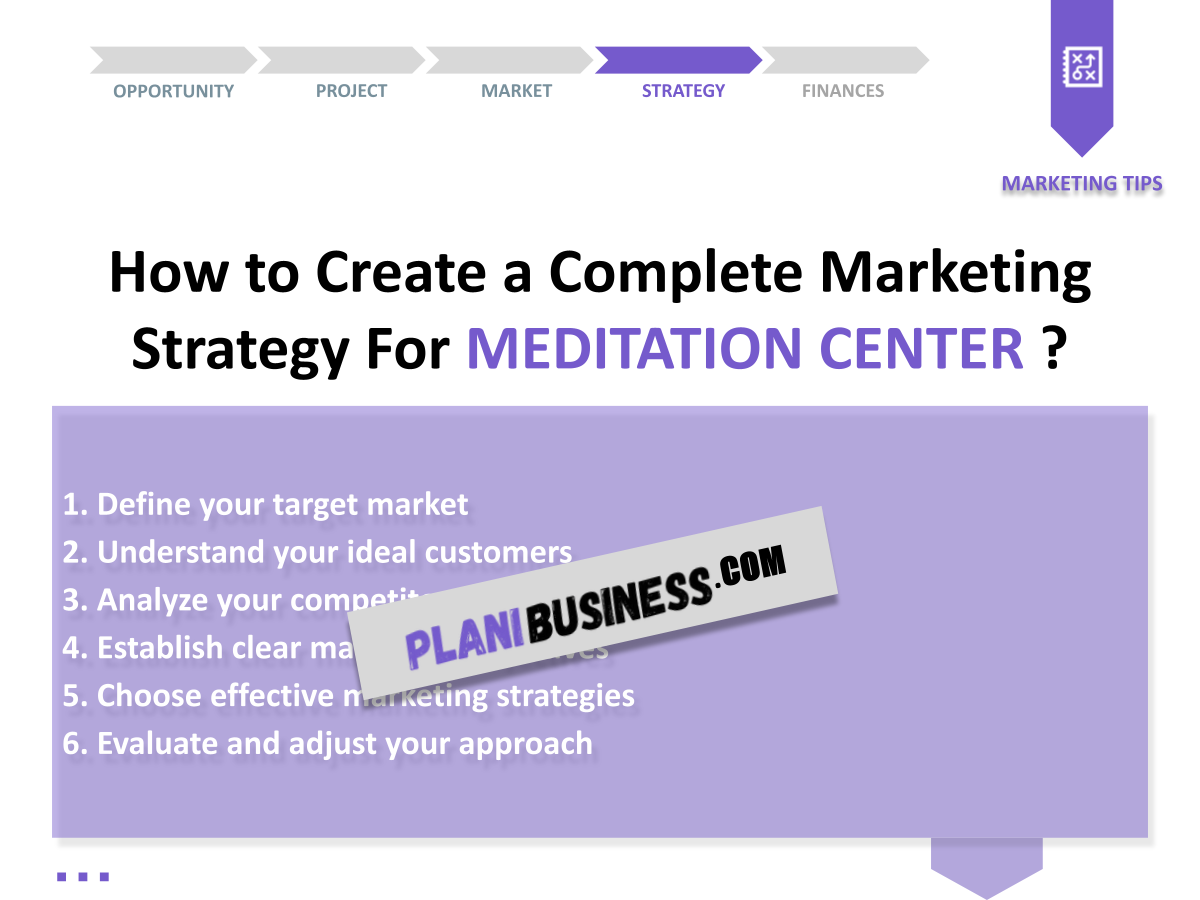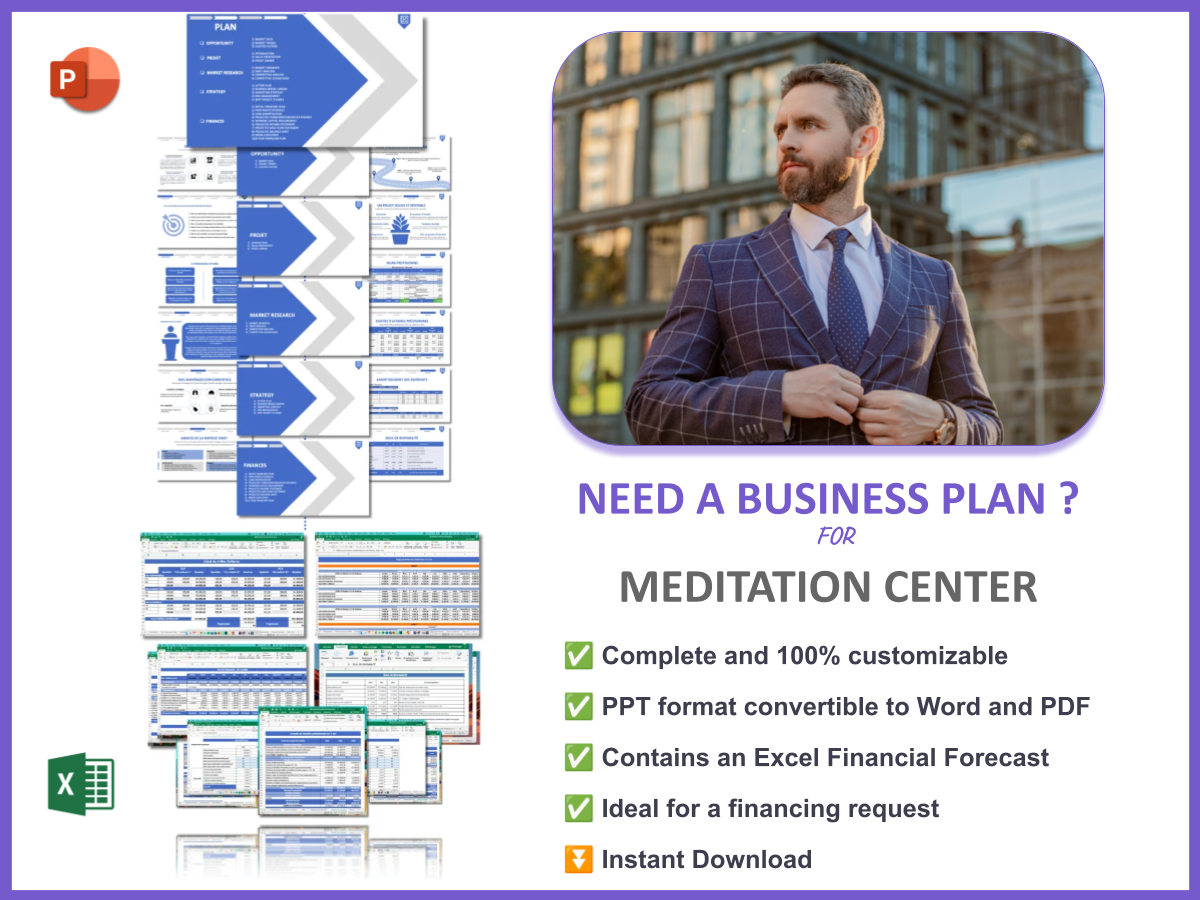Are you thinking about starting a Meditation Center Marketing Plan? You’re not alone! Many entrepreneurs in the wellness industry are discovering the incredible benefits of meditation, and they want to share their passion with others. But here’s the kicker: without a solid marketing plan, your beautiful meditation center could end up being just another hidden gem in your community.
A Meditation Center Marketing Plan is essential for reaching your target audience, increasing visibility, and ensuring that your center thrives. In this article, we’ll cover six key aspects to help you create a successful marketing strategy for your meditation center:
- Define your target market
- Understand your ideal customers
- Analyze your competitors
- Establish clear marketing objectives
- Choose effective marketing strategies
- Evaluate and adjust your approach
1. Define Your Target Market
| Market Segment | Description | Example |
|---|---|---|
| Age Group | Demographics of potential clients | 25-45 years old |
| Location | Geographic area to focus on | Urban vs. Rural |
Identifying your target market is the first step in your Meditation Center Marketing Plan. It helps you focus your marketing efforts on the right people. Think about who is most likely to benefit from your services and where they are located. By doing this, you can create tailored marketing messages that resonate with your audience.
For example, if you are targeting young professionals in urban areas, consider using digital marketing strategies such as social media advertising and email campaigns. On the other hand, if your audience is older adults in rural communities, community outreach and local newspaper ads might be more effective.
2. Understand Your Ideal Customers
| Customer Type | Characteristics | Needs |
|---|---|---|
| Beginners | New to meditation | Guidance and support |
| Experienced | Regular practitioners | Advanced techniques |
Your ideal customers will shape how you market your center. Take the time to understand their needs, preferences, and challenges, and tailor your services accordingly. For instance, beginners might be looking for introductory courses or workshops, while experienced meditators may seek advanced classes or specialized retreats.
Consider conducting surveys or interviews to gather insights directly from potential clients. This information can guide your marketing efforts and help you develop programs that truly resonate with your audience.
By understanding your ideal customers, you can create targeted marketing campaigns that speak directly to their interests and needs. This approach will not only attract new clients but also build a loyal community around your meditation center.
3. Analyze Your Competitors
| Competitor | Strengths | Weaknesses |
|---|---|---|
| Center A | Strong online presence | High prices |
| Center B | Diverse offerings | Limited marketing |
Knowing who your competitors are and what they offer can give you a competitive edge. Conducting a thorough analysis of your competitors is crucial for your Meditation Center Marketing Plan. This process helps you identify what sets your center apart and what gaps you can fill in the market.
Start by researching local meditation centers. Look at their websites, social media pages, and customer reviews. What services do they offer? How do they engage with their clients? Take notes on their strengths and weaknesses, as this will help you understand where you can improve and innovate.
For example, if you notice that a competitor has a strong online presence but high prices, you might consider offering more affordable options while maintaining quality. Alternatively, if another center provides diverse offerings but lacks marketing, you could focus on building a robust online marketing strategy to attract their clients.
4. Establish Clear Marketing Objectives for Your Meditation Center
| Objective | Measurement | Time Frame |
|---|---|---|
| Increase membership | 20% growth | 6 months |
| Boost social media engagement | 100 new followers | 3 months |
Your Meditation Center Marketing Plan should include clear, measurable objectives. This way, you can track your progress and adjust your strategies as needed. Setting SMART goals—Specific, Measurable, Achievable, Relevant, and Time-bound—will provide a roadmap for your marketing efforts.
For instance, instead of saying, “I want more members,” you can set a specific goal like “Increase membership by 20% in six months.” This clarity helps you focus your marketing activities and measure success effectively.
Consider creating a marketing calendar that outlines your objectives, the strategies you will use to achieve them, and the metrics you will track. This structured approach will keep you organized and accountable as you work toward your goals.
Regularly review your objectives and progress. If something isn’t working, don’t hesitate to pivot and try new tactics. Your marketing plan should be a living document that evolves with your center’s growth and the changing market landscape.
5. Choose Effective Marketing Strategies for Your Meditation Center
| Strategy | Details | Expected Outcome |
|---|---|---|
| Social Media Marketing | Engaging posts on platforms like Instagram | Increased awareness |
| Email Marketing | Weekly newsletters with meditation tips | Higher retention rates |
Selecting the right marketing strategies is crucial for the success of your Meditation Center Marketing Plan. You want to reach your audience where they are most active and engage them effectively. Here are some strategies to consider:
- Social Media Marketing: Use platforms like Instagram and Facebook to share content that resonates with your audience. Post meditation tips, success stories, and promotional offers. Engaging visuals and videos can capture attention and inspire people to visit your center.
- Email Marketing: Develop a mailing list and send regular newsletters to keep your community informed about upcoming classes, workshops, and events. Share valuable content, such as meditation techniques and mindfulness tips, to establish your center as a trusted resource.
- Content Marketing: Start a blog on your website that discusses various topics related to meditation and wellness. This will not only help with SEO but also position you as an authority in the field.
- Community Outreach: Partner with local organizations or wellness fairs to offer free meditation sessions. This can increase your visibility and help you connect with potential clients.
By implementing these strategies, you can effectively promote your meditation center and attract more clients. Remember to track the performance of each strategy to see what works best for your audience and adjust your approach accordingly.
6. Evaluate and Adjust Your Approach
| Evaluation Method | Frequency | Details |
|---|---|---|
| Surveys | Quarterly | Gather feedback from members |
| Analytics | Monthly | Track website traffic and engagement |
Regularly evaluating your marketing efforts is crucial for your Meditation Center Marketing Plan. It allows you to measure success and make informed decisions about future strategies. Here are some methods to evaluate your marketing approach:
- Surveys: Conduct surveys among your members to gather feedback about their experiences. Ask them what they love about your center and what could be improved. This direct input is invaluable for enhancing your services.
- Analytics: Use tools like Google Analytics to monitor your website traffic and user engagement. Pay attention to which pages are most popular and where your traffic is coming from. This data can help you refine your marketing strategies.
- Social Media Insights: Review your social media metrics regularly. Look at engagement rates, follower growth, and the performance of individual posts. This information can guide your content creation and posting schedule.
Be open to adjusting your strategies based on the data you collect. If a particular approach isn’t yielding the expected results, don’t hesitate to pivot and try something new. Your marketing plan should be flexible and responsive to the changing needs of your audience.
7. Example N°1 of Marketing Plan for a Meditation Center
| Steps | Actions | Details |
|---|---|---|
| Target Market | Identify key demographics | Focus on urban professionals |
| Ideal Customers | Create customer personas | Develop profiles for marketing |
| Competitors | Research local centers | Analyze their strengths and weaknesses |
| Marketing Objectives | Set specific goals | Increase members by 30% |
| Marketing Strategies | Implement SEO tactics | Enhance online visibility |
| Evaluation | Conduct member surveys | Adjust strategies based on feedback |
Let’s take a look at an example of a marketing plan for a meditation center. In this case, the center is targeting urban professionals who are often stressed and looking for ways to improve their mental well-being. The steps outlined above provide a comprehensive approach to developing a Meditation Center Marketing Plan.
First, they identify their target market by focusing on young professionals aged 25-40 living in busy urban areas. Next, they create detailed customer personas to understand the motivations and needs of these individuals.
By analyzing local competitors, the center can pinpoint what makes their offerings unique. They set clear marketing objectives, such as increasing membership by 30% within the next six months. To achieve this, they implement SEO strategies to improve their online presence, making it easier for potential clients to find them.
Finally, they regularly evaluate their progress through member surveys, using feedback to adjust their strategies as necessary. This approach ensures they remain responsive to their clients’ needs and market trends.
8. Example N°2 of Marketing Plan for a Meditation Center
| Steps | Actions | Details |
|---|---|---|
| Target Market | Focus on college students | Market to stress relief seekers |
| Ideal Customers | Create engaging content | Use relatable social media posts |
| Competitors | Examine pricing models | Offer competitive rates |
| Marketing Objectives | Increase social media followers | Grow by 50% in 3 months |
| Marketing Strategies | Host free workshops | Attract new members |
| Evaluation | Review attendance rates | Adjust based on participation |
In this example, the meditation center focuses on attracting college students who are often under significant stress due to academic pressures. They target this demographic by creating engaging content that resonates with young adults, utilizing relatable social media posts and campaigns.
By examining competitors, they find ways to differentiate themselves, such as offering competitive pricing models for students. Their marketing objectives include increasing their social media following by 50% within three months, which helps build community and brand awareness.
To further attract new members, they host free workshops on campus, allowing students to experience the benefits of meditation firsthand. Attendance rates are monitored, and strategies are adjusted based on participation levels, ensuring they remain relevant and appealing to their target market.
9. Example N°3 of Marketing Plan for a Meditation Center
| Steps | Actions | Details |
|---|---|---|
| Target Market | Identify corporate clients | Offer corporate wellness programs |
| Ideal Customers | Network with HR departments | Present benefits of meditation |
| Competitors | Identify unique selling points | Differentiate your services |
| Marketing Objectives | Secure 5 corporate contracts | Expand reach to organizations |
| Marketing Strategies | Develop referral programs | Encourage existing members to refer |
| Evaluation | Measure contract success rates | Adjust marketing strategies accordingly |
This example focuses on a meditation center that aims to attract corporate clients by offering wellness programs tailored for workplaces. The target market consists of businesses that recognize the importance of mental health for employee productivity.
To reach this audience, the center identifies key decision-makers, such as HR departments, and networks with them to present the benefits of incorporating meditation into their corporate wellness initiatives. By securing five corporate contracts, the center can significantly expand its reach and influence.
To differentiate from competitors, the center highlights its unique offerings, such as customized meditation sessions and workshops designed specifically for corporate environments. They also implement referral programs that encourage existing members to refer their companies, providing incentives for both parties.
Regular evaluation of the success rates of these contracts will help the center fine-tune its marketing strategies and ensure they meet the needs of corporate clients effectively.
10. Example N°4 of Marketing Plan for a Meditation Center
| Steps | Actions | Details |
|---|---|---|
| Target Market | Focus on local communities | Promote neighborhood workshops |
| Ideal Customers | Engage with community leaders | Build partnerships for outreach |
| Competitors | Analyze community engagement levels | Identify gaps in their offerings |
| Marketing Objectives | Host monthly community events | Increase local visibility |
| Marketing Strategies | Utilize local media | Advertise in community newsletters |
| Evaluation | Track event attendance | Adjust based on community feedback |
This example centers around a meditation center that aims to deeply integrate itself within the local community. The target market consists of residents who are interested in wellness and personal development.
To promote neighborhood workshops, the center engages with community leaders and organizations, building partnerships that can enhance outreach efforts. By analyzing competitors, they identify gaps in community engagement and tailor their offerings to fill those gaps.
Setting a goal to host monthly community events allows the center to consistently connect with local residents and build relationships. Utilizing local media, such as community newsletters and bulletin boards, helps spread the word about these events and increases visibility.
Attendance at each event is tracked, and feedback is gathered from participants to refine future workshops and ensure they meet the community’s needs. This approach fosters a sense of belonging and encourages more individuals to embrace meditation as part of their lives.
11. Example N°5 of Marketing Plan for a Meditation Center
| Steps | Actions | Details |
|---|---|---|
| Target Market | Identify health and wellness influencers | Collaborate for promotions |
| Ideal Customers | Target health-conscious individuals | Market benefits of meditation |
| Competitors | Examine their social media presence | Differentiate through unique content |
| Marketing Objectives | Increase social media engagement | Grow interaction by 40% |
| Marketing Strategies | Create partnership programs | Leverage influencer marketing |
| Evaluation | Monitor social media metrics | Adjust strategies as necessary |
In this example, the meditation center targets health and wellness influencers to expand its reach and credibility. By collaborating with these influencers, the center can promote its services to a broader audience that values wellness and mindfulness.
Identifying health-conscious individuals as the ideal customers helps the center craft marketing messages that resonate with this demographic. They focus on promoting the benefits of meditation, such as stress reduction, improved focus, and emotional balance.
To achieve marketing objectives, such as increasing social media engagement by 40%, the center creates unique content that stands out from competitors. They develop partnership programs with influencers, offering them free classes or exclusive access to workshops in exchange for social media promotion.
Regularly monitoring social media metrics allows the center to track the effectiveness of their campaigns. By analyzing which posts generate the most engagement, they can adjust their strategies accordingly, ensuring that their marketing efforts remain relevant and impactful.
12. Example N°6 of Marketing Plan for a Meditation Center
| Steps | Actions | Details |
|---|---|---|
| Target Market | Focus on mental health advocates | Offer workshops for stress management |
| Ideal Customers | Collaborate with therapists | Promote meditation as a therapy tool |
| Competitors | Review their service offerings | Enhance your unique features |
| Marketing Objectives | Develop partnerships with local clinics | Expand reach to new clients |
| Marketing Strategies | Host free community classes | Encourage participation and referrals |
| Evaluation | Assess class attendance | Make adjustments based on interest |
This example highlights a meditation center that aims to connect with mental health advocates and professionals. By focusing on offering workshops specifically designed for stress management, the center can address a pressing need within this community.
Collaborating with therapists allows the center to promote meditation as a valuable tool in therapy. This partnership not only enhances credibility but also helps in reaching individuals who may benefit from mindfulness practices.
The marketing objectives include developing partnerships with local clinics to expand their reach and attract new clients. Hosting free community classes is an effective strategy to introduce people to meditation, allowing them to experience its benefits firsthand.
Attendance at these classes is tracked, and feedback is gathered to refine future offerings. By remaining flexible and responsive to participants’ interests, the center can continuously improve its programs and marketing strategies.
13. Example N°7 of Marketing Plan for a Meditation Center
| Steps | Actions | Details |
|---|---|---|
| Target Market | Identify health and wellness fairs | Participate for exposure |
| Ideal Customers | Engage with attendees | Provide free meditation samples |
| Competitors | Analyze their event strategies | Differentiate your approach |
| Marketing Objectives | Generate leads from events | Aim for 50 new contacts |
| Marketing Strategies | Hand out promotional materials | Inform about upcoming classes |
| Evaluation | Follow up with leads | Convert interest into memberships |
This final example centers on a meditation center that seeks to participate in local health and wellness fairs. The target market includes attendees who are already interested in health and wellness, making them prime candidates for meditation services.
By engaging with attendees and providing free meditation samples, the center can attract interest and showcase the benefits of their offerings. This hands-on experience can convert potential clients into regular members.
The marketing objectives focus on generating leads from these events, with a goal of acquiring at least 50 new contacts. To achieve this, the center distributes promotional materials that highlight upcoming classes and workshops.
After the event, following up with leads is essential to convert interest into memberships. By maintaining communication and offering personalized invitations to join classes, the center can effectively grow its community and expand its reach.
Conclusion
Creating a successful Meditation Center Marketing Plan is essential for attracting clients and ensuring the sustainability of your center. By understanding your target market, analyzing competitors, and implementing effective marketing strategies, you can foster a community that embraces the benefits of meditation.
As you develop your marketing plan, consider utilizing a comprehensive business plan template to guide your efforts. Check out this Meditation Center Business Plan for a structured approach to your business journey.
Additionally, if you’re looking for more insights, be sure to read our articles on How to Develop a Meditation Center? and How to Create a SWOT Analysis for Meditation Center. These resources can provide valuable information to help you succeed in your meditation center venture.
FAQ
- What is a Meditation Center Marketing Plan?
A Meditation Center Marketing Plan outlines the strategies and tactics you will use to attract and retain clients at your meditation center. - How do I identify my target market?
Research demographics, interests, and behaviors of potential clients to define your target market. Consider factors like age, location, and lifestyle. - What are some effective marketing strategies for a meditation center?
Consider strategies such as social media marketing, email campaigns, community outreach, and partnerships with local organizations. - How can I evaluate the success of my marketing efforts?
Use metrics like membership growth, event attendance, and engagement rates on social media to measure the effectiveness of your marketing strategies. - What should I include in my marketing objectives?
Your marketing objectives should be specific, measurable, achievable, relevant, and time-bound (SMART), such as increasing membership by a certain percentage within a set timeframe. - How can I use social media to promote my meditation center?
Create engaging content that resonates with your audience, share meditation tips, success stories, and promote upcoming events to build a community online. - What role do workshops play in attracting new clients?
Hosting workshops allows potential clients to experience the benefits of meditation firsthand, which can lead to increased interest and memberships. - How do I analyze my competitors?
Research local meditation centers to identify their strengths and weaknesses, service offerings, pricing, and marketing strategies to find opportunities for differentiation. - What types of partnerships can benefit my meditation center?
Collaborate with local businesses, wellness influencers, and community organizations to expand your reach and enhance your credibility. - How can I adjust my marketing plan based on feedback?
Collect feedback from clients through surveys and conversations, and use that information to refine your offerings and marketing strategies to better meet their needs.







